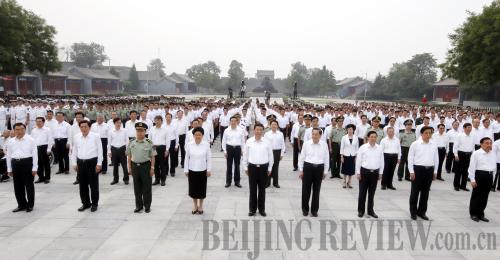|
 |
|
NATIONAL MEMORIAL: Chinese President Xi Jinping (center, first row) and more than 1,000 people attend at a ceremony commemorating the start of the War of Resistance Against Japanese Aggression (1937-45) in Beijing on July 7 (JU PENG) |
Situated 15 km southwest of Beijing's city center, Lugou Bridge is an 800-year-old stone structure, which the Italian merchant, traveler and explorer Marco Polo wrote of in one of his journals, earning it its more commonly recognized name in English—the Marco Polo Bridge. Though Marco Polo's writings about its exquisite architecture may have made it known in the West, for the Chinese people, the bridge has been imbued with a significance it cannot be separated from ever since 1937.
On the night of July 7, 1937, Japanese troops conducted a drill near the bridge without informing the Chinese garrison. During the drill, the Japanese army claimed a solider had gone missing afterward and requested they be allowed cross the bridge to search for him. When they were refused by the Chinese army, the Japanese opened fire.
The battle, henceforth known as the Lugou Bridge Incident, marked the start of China's eight-year-long War of Resistance Against Japanese Aggression, which claimed more than 35 million Chinese lives. In less than a month after the incident, Beijing was captured.
"History is history and facts are facts. Nobody can change either history or the facts. Anyone who intends to deny, distort or beautify the Japanese history of aggression will not find agreement among the Chinese people nor the people of any other country," said Chinese President Xi Jinping at a ceremony commemorating the 77th anniversary of the Lugou Bridge Incident in Beijing on July 7.
Xi made the remarks in response to repeated attempts made by right-wing elements in Japan's political sphere to play down the country's history of aggression and their visits to the notorious Yasukuni Shrine, which honors war criminals, a move that has alarmed many of its regional neighbors including China and South Korea.
These wounds have once again been reopened as the cabinet of Prime Minister Shinzo Abe on July 1 approved a resolution that would allow the country to exercise their right to collective self-defense by reinterpreting its pacifist Constitution, despite strong protests both at home and abroad.
According to Article 9 of Japan's Constitution, the country gave up all rights to a military barring a self-defense force after World War II, owing to the heinous war crimes it committed in other Asian countries.
However, the July 1 resolution would enable Tokyo to fight for "countries with close ties" with Japan even though Japan itself is not under attack. This move paves the way for Japan to send its troops to fight overseas, which many believe is the first step in what could be the renewed militarization of Japan.
During the ceremony on July 7, President Xi also unveiled a sculpture honoring the veterans who fought in the war from 1937 to 1945.
"The inauguration of this sculpture is to commemorate those who devoted their lives to fighting for our independence and freedom as well as those who made great contributions to peace and justice, and to console the victims of the war," Xi said.
Undeniable
Within five months of Japan's invasion into Beijing, they captured a large part of Chinese territory in the north and east. After they took over Nanjing, historically also known as Nanking and capital of China at the time, on December 13, 1937, they embarked on a series of atrocities including wanton rape, plunder, arson and destruction throughout the city. The Nanjing Massacre lasted for six weeks till the end of January 1938. More than 300,000 Chinese were killed.
In 1997, on the 60th anniversary of the Nanjing Massacre, a book on the slaughter was published in the United States—The Rape of Nanking: The Forgotten Holocaust of World War II. The author, Iris Chang, was a Chinese-American historian and journalist who spent three years researching the massacre and searching for materials and survivors. Chang tragically took her own life seven years later in 2004 while researching for her fourth book, which was to be on the Bataan Death March, where the forcible transfer of Filipino and U.S. prisoners of war by the Japanese military resulted in the death of an estimated 2,500-10,000 Filipinos and a further 100-650 Americans.
The Rape of Nanking, which remained on The New York Times Bestseller list for 10 weeks, documents atrocities committed against the Chinese by the Japanese army, and includes interviews with victims. Based on the book, a U.S.-produced documentary film, Nanking, was released in 2007.
| 